At the 1967 European Championships, Czechoslovak gymnast Věra Čáslavská scored two 10.0s. One year later, during the lead-up to the Mexico City Olympics, the Soviet gymnasts scored four 10.0s at their domestic competitions.
Given the flurry of 10.0s just before the 1968 Olympics, it’s somewhat surprising that there weren’t any 10.0s in Mexico City.
Let’s take a look at what happened at the USSR Nationals and the USSR Cup.
WAG Soviet Nationals | WAG Soviet Cup | MAG Soviet Nationals | MAG Soviet Cup
The Women: Soviet Nationals
Results
1. Kuchinskaya 78.385
2. Voronina 78.300
3. Petrik 77.750
4. Karaseva* 77.275
5. Burda 76.900
6. Demyanenko 75.725
*Also known as Kharlova, Karasyova, and Kovalenko
Kuchinskaya had the flu and was third after compulsories behind Larisa Petrik and Zinaida Voronina (née Druzhinina. She married World champion Mikhail Voronin).
It was very strange for the fans of Natasha that she was only the third after the compulsory programme finished. The first was Larissa Petric and then Zinaida Voronina. It was because of the fact that before the championships she got the flu and hadn’t trained properly.
Mademoiselle Gymnast, Sept./Oct. 1968
After three rotations of optionals competition, Petrik, Voronina, and Kuchinskaya were tied with a 68.2. Then, Kuchinskaya pulled into the lead.
All three: Petrik, Voronina, and Kuchinskaya had the same score – 68.2. Petrik and Voronina had to perform on the carpet and Natasha on the uneven bars. You know that Petrik and Voronina are very good at Free-X. All the spectators kept their breath to watch the outcome of this. The first on the carpet was Larissa. Her new composition was unforgettable, but she’d made some mistakes and got only 9.5. Voronina did her best and got 9.8. Natasha got 9.85 and became the leaders with the result – 78.15.
Mademoiselle Gymnast, Sept./Oct. 1968
But there was another day of optionals. Petrik scored a 10.0 on vault and floor on the second day of optionals.
The best six began on the balance beam. Natasha did some new tricks and got 9.8, Voronina 9.7 and Larissa 9.75. Next event Vaulting: Our coaches after Dortmund put much effort to improve vaulting and in Leningrad we saw the results. All the best gymnasts made a deadstop after jumping, a fact very pleasant for us. Petrik, especially was in good form. Her jump was fantastic. 10.0 the strict judges gave her for the first attempt and Larissa refused to do second try (quite reasonable, isn ‘t it?). On the floor Larissa again got 10.0. I’ll never forget her performance. It was magnificent. Everyone thought that Larissa would be the champion but again this “but” . . . the tense struggle perhaps has told on her nerves and she had made some slips on the last event, uneven bars, only 9.2 5, and not the slightest hope for the title now. Voronina did her new combination very quietly and with confidence, 9.8.
Mademoiselle Gymnast, Sept./Oct. 1968
Kuchinskaya needed a 10.0 to win. A little girl yelled out, “C’mon, Natasha, get the 10!” Natasha got the 10.0.
Everyone waited with impatience for Natasha. She was the last. There was a dead silence in the hall, and all 6,000 eyes were on Natasha. Suddenly a young girl’s voice was heard: “come on, Natasha! get the ten.” Natasha turned her head, gave a moment’s smile and again became very serious. She had to get 9.95 to be the National Champion. You understand that it is not so easy. The day before Natasha got 9.75. How it will come this time? Slowly she came up to the bars. Stood for a second and then began her routine. She flew from one bar to another with such speed doing different twists and I don’t know what and finished her exercise with the “hecht” with full twist (360″) from the high bar to a dead-stop. Everyone sat motionless and then there was a storm of applause. All shouted “ten, ten, ten” for twenty minutes and the judges unanimously gave her 10.0. Natasha became the All-Around champion of the USSR.
Mademoiselle Gymnast, Sept./Oct. 1968
Note: Yuri Sabirov included the anecdote about the child in the Russian version of this article:
Воронина очень уверенно выпол нила свое упр аж нение и получила 9,8 балла. Заканчивала соревнование финалистов Н. Кучинская . Весь зрительный зал замер. И вдруг откуда-то с галерки раздался детский возглас: «Наташенька ! На все десять!». Действительно, Наташе нужно было получи ть по крайней мере 9,95 балла, чтобы стать чемпионкой . Все ждут. Блестяще выполнила упражнение Наташа. но, на мой взгляд , все же допустила одщу малнькую-малнькую ошибку. Но упражнение было настолько сложным, что судьи простили ей это и единодушно выставили 10 баллов.
Izvestiia, May 28, 1968
Interestingly enough, when Sabirov rewrote the article for the Mademoiselle Gymnast readership, he didn’t mention the imperfections in Kuchinskaya’s bar routine. In Russian, he noted that Kuchinskaya’s routine had a small mistake, but the judges were lenient because of her routine’s difficulty:
Natasha performed the exercise brilliantly. but, in my opinion, she nevertheless made one small, small mistake. But the exercise was so difficult that the judges forgave her and unanimously gave her 10 points.
Блестяще выполнила упражнение Наташа. но, на мой взгляд , все же допустила одщу малнькую-малнькую ошибку. Но упражнение было настолько сложным, что судьи простили ей это и единодушно выставили 10 баллов.
Izvestiia, May 28, 1968
Do you see a pattern? 10.0s often have small mistakes.
Why did Larisa Petrik take third with two 10.0s?
She believed that she didn’t manage her energy and didn’t remain calm. She gave floor and vault everything she had, which tired her out.
Я удовлетворена этими соревнованиями, хотя и проиграла. Некоторые выступают, как работают, тратят энергии ровно столько, сколько нужно, чтобы от первого снаряда прийти к последнему, выполнив все, что положено. В том, что я так не умею, моя слабость, но и моя сила. Мне никогда не удается рассчитать усилия, я увлекаюсь и выкладываюсь до предела, хотя и знаю прекрасно, что в конечном итоге побеждает спокойствие. Душевный подъем, который я испытала, выполняя прыжки и вольные упражнения, вместе с удовлетворением принес усталость. А усталость наступила слишком рано — подъема не хватило на последний снаряд… Зато вольные, про которые все мне твердили, что они слишком трудны, я сделала на «десятку»!
Nedelia, June 2, 1968
In the opinion of the sportswriter Kolesnikova, Petrik was the true heroine. From the unrefined schoolgirl, she had matured and become art itself. (“From a schoolgirl, she became a student, and from the original ‘spark of God’ appeared in her the light of true art.”)
ЛАРИСА ПЕТРИК—вот о ком хочется сказать как об истинной героине прошлой спортивной недели. За два года, минувшие с первенства мира, когда имя Петрик впервые громко прозвучало среди имен сильнейших гимнасток, эта девочка, тогда еще резкая, вся какая-то не отточенная и по мастерству, и по манере держаться, и по характеру, повзрослела необыкновенно. Из школьницы она стала студенткой, а от самобытной «искры божьей» появился в ней огонек настоящего искусства.
Nedelia, June 2, 1968
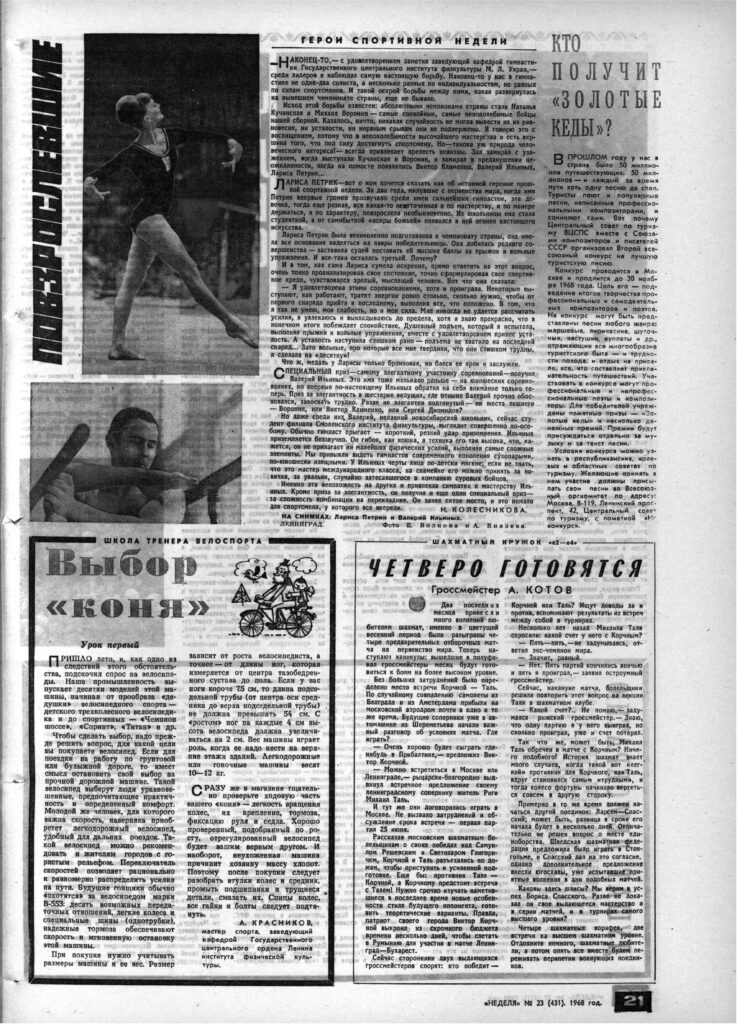
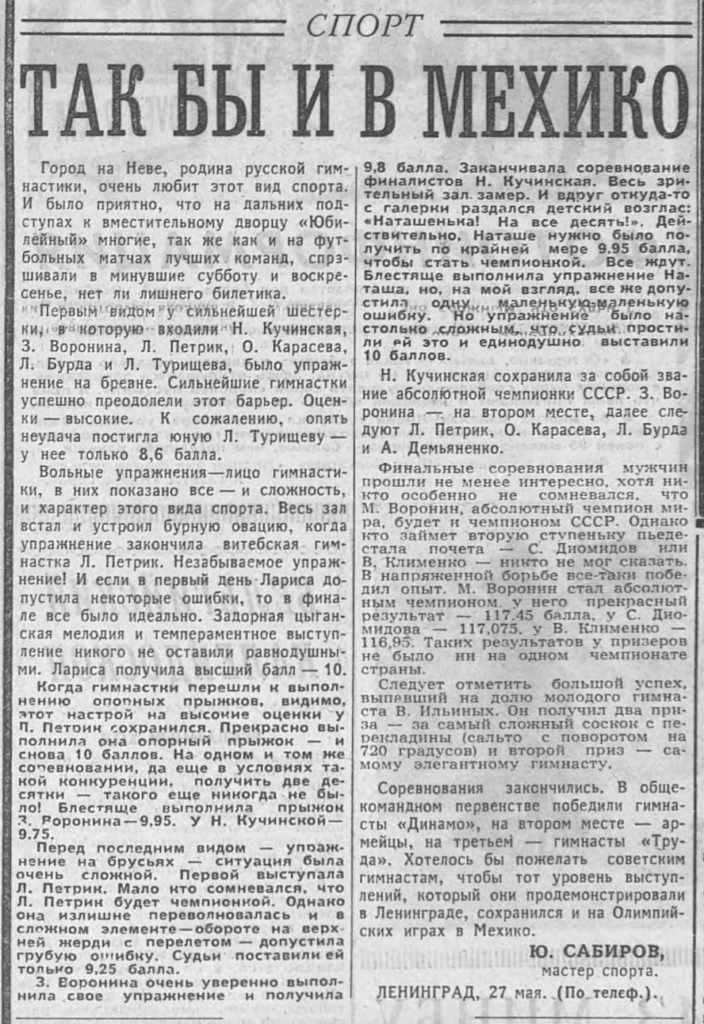
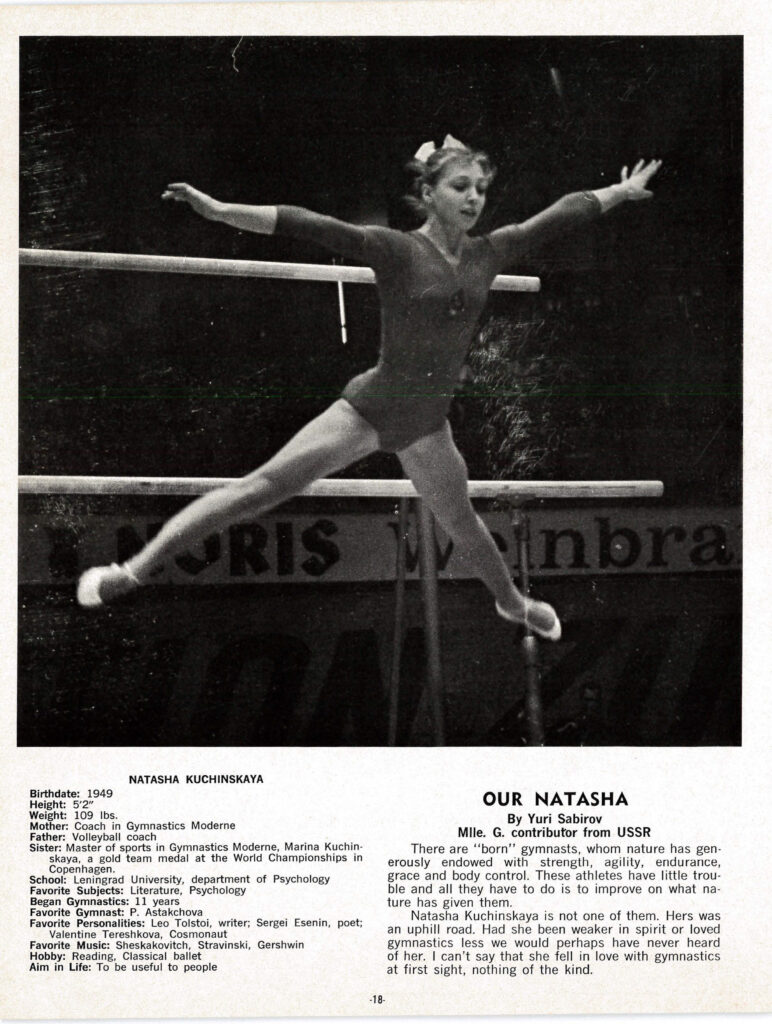
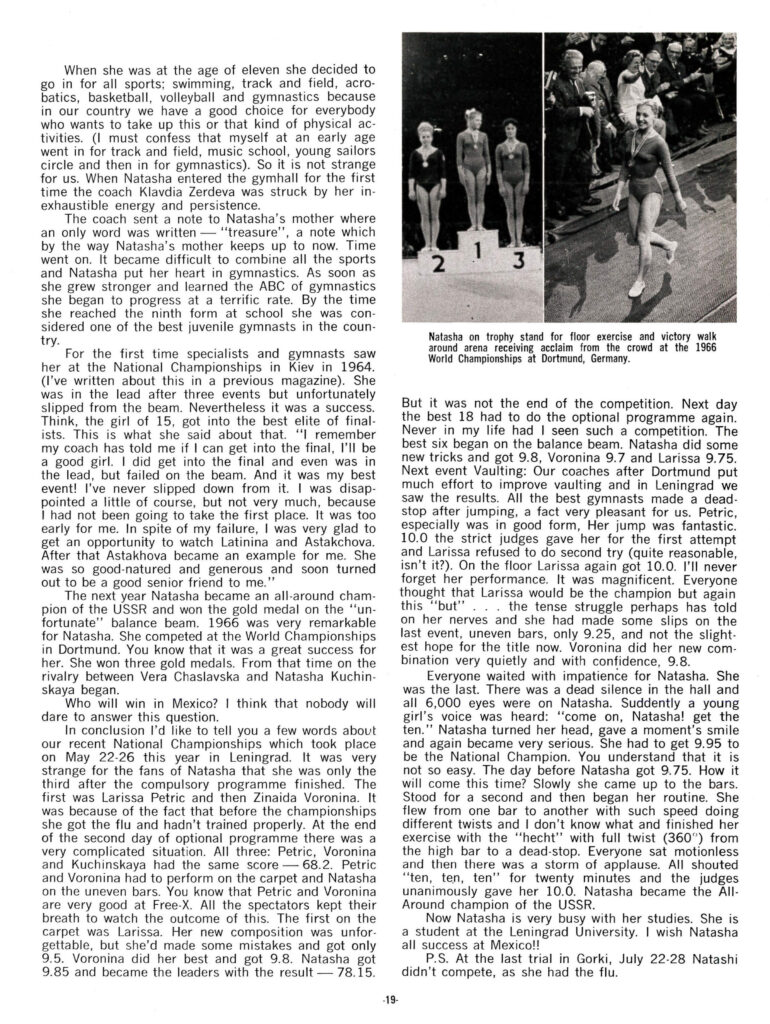
Competition Footage
Nostalgia: A certain demographic of readers will remember learning the toe-shoot over the low bar that Tourischeva performed below.
Petrik on UB: Her uneven bar routine was innovative. Check out her hip circle/hecht ½ release, which transitions into a cast 1/1 from low to the high bar.
Side note: If you’re trying to figure out where you saw this release (relatively) recently, Nicole Pechanec of Parkette’s/the Czech Republic/Stanford used to compete this release:
Pechanec also performed it internationally at the 2006 World Championships.
The Women: Soviet Cup
In addition to the competition in May, the gymnasts had another trial in Gorky in July.
Once again, Kuchinskaya had the flu.
P.S. At the last trial in Gorki, July 22-28 Natashi didn’t compete, as she had the flu.
Mademoiselle Gymnast, Sept./Oct. 1968
Zinaida Voronina won the competition. She scored a 10.0 on floor.
Обладательница Кубка СССР Зинаида Воронина стала чемпионкой страны в двух видах многоборья — в опорных прыжках и в вольных упражнениях, причем с предельно высокими результатами: за вольные— 10 баллов, за прыжки — 9,9.
Izvestiia, July 27, 1968
15-year-old Lyubov Burda won gold on bars and beam. She performed her famous Burda twirl (an underswing 1.5 turn to regrasp).
На брусьях и на бревне золотые медали завоевала пятнадцатилетняя воронежская школьница Люба Бурда. Ее упражнение на брусьях было очень сложным, в него входит, уникальный элемент — «вертушка на 540 градусов».
Izvestiia, July 27, 1968
Side note: You can watch a little documentary on Burda from 1967
And here’s a GIF of the Burda Twirl from the 1970 World Championships.
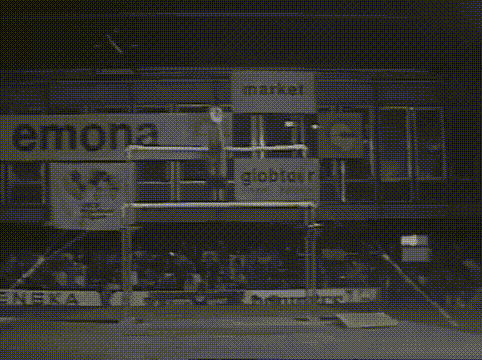
Voronina scored a 78.25. Burda was in second with a 77.95. And Tourischeva was in third with a 77.6.
ГОРЬКИЙ, (ТАСС). Кубок CCCP no гимнастике под аплодисменты многочисленных зрителей завоевала москвичка Зинаида Воронина. У нее 78,25 балла. Впервые, выполняя на официальных соревнованиях вольные упражнения, приготовленные для Мехико, в произвольной программе Воронина удостоилась высшей оценки — 10 баллов! Второе и третье места заняли 15-летние школьницы Люба Бурда из Воронежа — 77,95 балла и лидирующая после обязательной программы обладательница Кубка 1967 года Людмила Турищева из Грозного —77,6 балла.
Gudok, July 25, 1968
Tourischeva had a minor injury. (The article doesn’t say what it was.)
Людмила Турищева не смогла принять участие в споре сильнейших из-за небольшой травмы.
Izvestiia, July 27, 1968
Larisa Petrik won silver on floor and vault and bronze on beam.
Две серебряные медали (в опорном прыжке и в вольных упражнениях) и одну бронзовую (в упражнениях на бревне) завоевала талантливая гимнастка Лариса Петрик.
Izvestiia, July 27, 1968
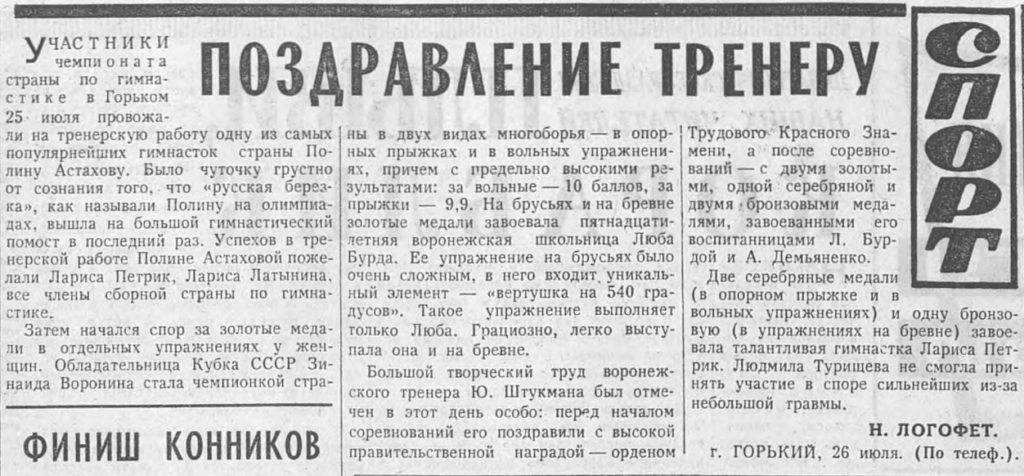
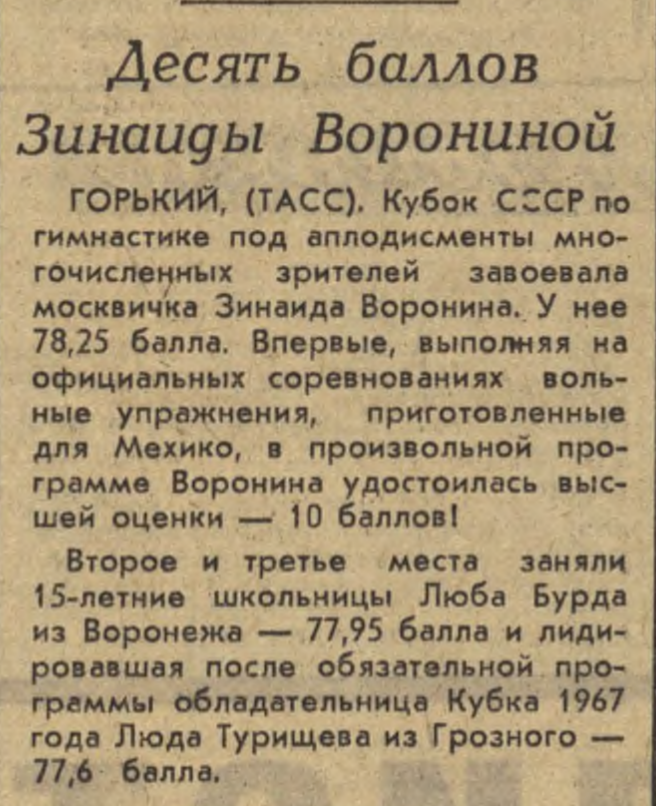
The Men: Soviet Nationals
Results:
- Voronin 117.450
- Diomidov 117.075
- V. Klimenko 116.950
- Lisitsky 116.075
- Ilinykh 115.250
- Tsapenko 114.450
Voronin won the men’s competition. He and Kuchinskaya were seen as the calmest gymnasts on the team. “Nothing could throw them off balance; they were not subject to either fatigue or nerves. I say this with admiration because calmness of the highest order is the pinnacle of what an athlete can achieve.”
Исход этой борьбы известен: абсолютными чемпионами страны стали Наталья Кучинская и Михаил Воронин — самые спокойные, самые непоколебимые бойцы нашей сборной. Казалось, ничто, никакая случайность не могла вывести их из равновесия, ни усталости, ни нервным срывам они не подвержены. Я говорю это с восхищением, потому что в непоколебимости высочайшего мастерства и есть вершина того, что под силу достигнуть спортсмену.
Nedelia, June 2, 1968
Valery Ilinkyh was the most elegant gymnast.
СПЕЦИАЛЬНЫЙ приз—самому элегантному участнику соревнований—получил Валерий Ильиных.
Nedelia, June 2, 1968
Ilinkyh also performed the most difficult dismount off high bar: a double full.
Следует отметить большой успех, выпавший надолго молодого гимнаста В. Ильиных . Он получил два приза — за самый сложный соскок с перекладины (сальто с поворотом на 720 градусов) н второй приз — самому элегантному гимнасту .
Izvestiia, May 28, 1968
Ilinykh lands without making a sound. He is flexible “like a cat,” and he has such great technique that he makes the most difficult elements look effortless.
Ильиных приземляется беззвучно. Он гибок, как кошка, а техника его так высока, что, кажется, он не прилагает ни малейших физических усилий, выполняя самые сложные элементы.
Nedelia, June 2, 1968
With the face of a child, Ilinykh impressed on high bar, and in the words of the sportswriter, “he has everything ahead of him.”
Мы привыкли видеть гимнастов современного поколения сухопарыми, по-юношески изящными. У Ильиных черты лица по-детски мягкие; если не знать, что это мастер международного класса, на скамейке его можно принять за новичка, за увальня, случайно затесавшегося в компанию суровых бойцов. Именно эта непохожесть на других и привлекла симпатии к мастерству Ильиных. Кроме приза за элегантность, он получил и еще один специальный приз—за сложность комбинации на перекладине. Он занял пятое место, и это немало для спортсмена, у которого все впереди.
Nedelia, June 2, 1968
Competition Footage
The Men: Soviet Cup
What follows is a short translation of an article from the July 25, 1968 edition of Izvestiia.
Muscovite S. Diomidov won the 1968 USSR Gymnastics Cup. The second and third places were taken by 19-year-old Muscovite V. Klimenko and veteran V. Lisitsky (Moscow region).
The main feature of the competition, which took place on July 24 in Gorky, was the excellent performance of young gymnasts V. Klimenko, V. Ilinykh, and V. Soshin. Klimenko, who competed at the schoolchildren’s sports contest last year (by the way, he won all the gold medals there), this year is fighting for gold medals on equal terms with the venerable adults. After three exercises, V. Klimenko and S. Diomidov were tied. The fate of the Cup was decided on the fourth round — the rings. The rings are Klimenko’s “Achilles heel” so far. And this time he lost important tenths on them.
Before the last event of the all-around — parallel bars — the leaders were 0.35 points apart. But Diomidov is the world champion on parallel bars. Not wanting to risk it, he took out the Diomidov and was awarded a 9.9. I would like to note the beautiful, difficult, perfectly executed routine on the high bar of V. Ilinykh, and the performance of V. Soshin on the rings.
Results:
1. S. Diomidov (Moscow) —117.2 points
2. V. Klimenko (Moscow) —116.8 points
3. V. Lisitsky (Moscow region) — 116.0.
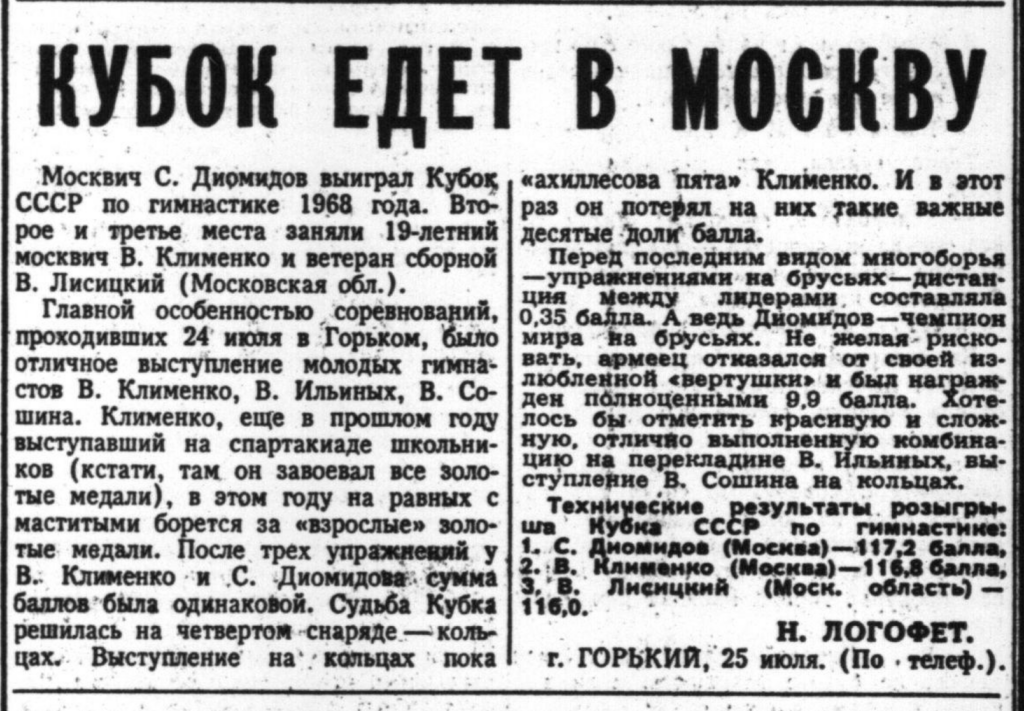
My Thought Bubble
As I said above, it’s somewhat surprising that there weren’t any 10.0s at the 1968 Olympics given the number of 10.0s prior to the Olympic Games. If you haven’t been keeping track, here are the ones that I’m aware of from the 1965-1968 quadrennium. (There could be more.)
WAG – National Level
Čáslavská – Floor – 1966 Czechoslovak Nationals
Zuchold – Floor – 1968 East German Championships
Zuchold – Vault – 1968 East German Championships
Janz – Vault – 1968 East German Championships
Petrik – Vault – 1968 Soviet Nationals
Petrik – Floor – 1968 Soviet Nationals
Kuchinskaya – Bars – 1968 Soviet Nationals
Voronina – Floor – 1968 USSR Cup
MAG – National Level
Medvedev – Parallel Bars – 1965 Soviet Nationals (June)
Diomidov – Rings – 1965 Soviet Nationals (November)
WAG – International Level
Čáslavská – Beam – 1967 European Championships
Čáslavská – Floor – 1967 European Championships
⁂ ⁂ ⁂
Note: During the previous quad, Muriel Grossfeld received a 10.0 on floor during the 1964 Olympic Trials:
Mrs. Grossfeld achieved perfection when all three judges gave her a rare perfect 10-point score in the floor exercise. She brought an overflow crowd of 5,000 to its feet with the spectacular performance.
New York Times, August 30, 1964
More on 1968
More on Perfect 10s